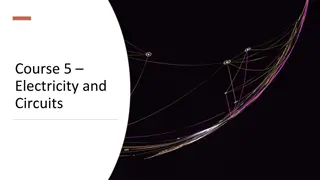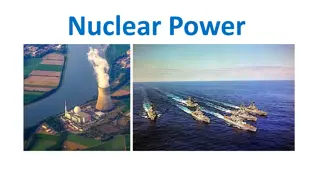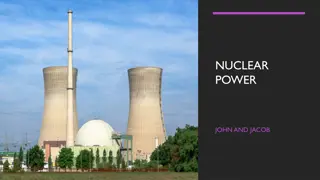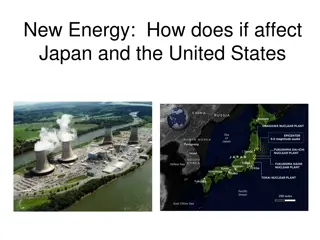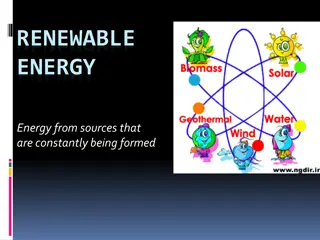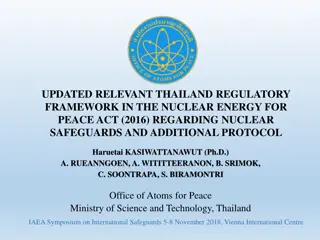The Role of Nuclear Power in India's Energy Mix and Electricity Sector Growth
Exploring the significance of nuclear power in India's energy landscape, alongside a timeline of energy technologies and the increasing demand for electricity in the country. The focus is on the challenges of meeting electricity needs for a growing population in India, with insights on future projections and potential solutions.
Download Presentation

Please find below an Image/Link to download the presentation.
The content on the website is provided AS IS for your information and personal use only. It may not be sold, licensed, or shared on other websites without obtaining consent from the author.If you encounter any issues during the download, it is possible that the publisher has removed the file from their server.
You are allowed to download the files provided on this website for personal or commercial use, subject to the condition that they are used lawfully. All files are the property of their respective owners.
The content on the website is provided AS IS for your information and personal use only. It may not be sold, licensed, or shared on other websites without obtaining consent from the author.
E N D
Presentation Transcript
Importance of energy and the Importance of energy and the role of nuclear power in India s role of nuclear power in India s energy mix energy mix R B Grover Emeritus Professor, Homi Bhabha National Institute, Mumbai 27thIAEA Fusion Energy Conference, Ahmedabad, India 22 October 2018
What bent the curve of human history? 2011 CE World Population 7B is 1/2 meter above this page Ian Morris, Why the West Rules For Now: Patterns of History and What They Reveal About the Future, 2010 1803 CE: Population 1 billion What happened around this time to cause rapid population rise Population 300 M in the year zero 4000 BC: Population 7 million 5000 BCE 4000 BCE 3000 BCE 2000 BCE 1000 BCE 0 1000 CE 2000 CE 3000 CE
Energy technologies and use timeline 1957 CE World s first large- scale nuclear power plant Shippingport, Pennsylvania 4000 BCE 1880 CE Coal is used to generate electricity 0 1954 CE Solar voltaic cells invented 644 CE 1100 CE 1942 CE Fermi team s first self-sustaining nuclear chain reaction 1300 CE 1860 CE Gasoline-powered engine invented 1698 CE 1904 CE First geothermal power plant built in Italy 1785 CE 1859 CE First oil production well drilled in Pennsylvania 1787 CE 1300 CE Hopi Indians use coal for heating cooking, and firing pottery. Anasazi Indians build cliff dwellings with southern exposures for solar heating 1803 CE 1890 CE Solar engine used to run a printing press 1826 CE John Ericson builds hot-air engine powered by the sun 1826 CE 1859 CE 1803 CE Steam locomotive invented 1860 CE 1100 CE Windmills introduced in Europe 1887 CE First automatically operating wind turbine 1880 CE 1785 CE First water- powered fabric loom invented 1787 CE Steamboat invented 1885 CE 1885 CE Gasoline-powered automobile invented 1887 CE 644 CE First vertical axis windmill used in Iran 1890 CE 1904 CE 1698 CE First steam pump invented 1942 CE 1954 CE Coal for heating Water-powered grain mills 1957 CE World Population 7 Million 2013 CE 5000 BCE 4000 BCE 3000 BCE 2000 BCE 1000 BCE 0 1000 CE 2000 CE 3000 CE
Select data regarding electricity sector Select data regarding electricity sector CAGR for electricity generation in India for the period 2007-08 to 2016-17 was 5.83% for utilities and non-utilities. Large demand for space cooling and conditioning solutions, and cold chain. India cooling action plan - draft released for comments. Demand for white goods is increasing. Electricity to manufacture as well as operate the machines. In short, electricity demand is growing and will continue to grow in coming decades. Per capita annual consumption in Singapore: 8949; Malaysia: 4656; Thailand: 2621. (World average: 3052kWh) India cannot be different. Per capita consumption: 5000; 1.6 billion people; 7% T&D losses. Total requirements: 8600 billion kWh. Hydro, wind and solar together cannot meet more than a quarter of the projected requirement. (Hydro generation in 2017-18 was 122 BU, all additional potential must be realized. Solar potential 770 GW; wind potential: 302 GW. Assuming operation at 20%, solar and wind can generate 1840 BU) 22 October 2018 27th IAEA FEC 2018 4
Meeting electricity demand Meeting electricity demand Opinion as well as evidence in favour of climate change is overwhelming. Biophysical issues are global. So the global picture. In 2015, share in TPES Fossil: 81.4%; nuclear: 4.9%; hydro: 2.5%; biofuels and waste: 9.7%; solar and others: 1.5%. Global energy infrastructure (mines, fuel transportation, dams, petro-chemical complexes, gas pipes, electricity generating plants, transmission and distribution network has been built over a long time, and any transition in global infrastructure will need investment: capital, materials, energy, human resources and time. However, a shift in favour of low-carbon sources identified to include hydro, nuclear, solar and wind is desirable. Also a well formulated system s approach system consisting of all elements of the chain from energy mine to consumer, and interaction of the elements with biosphere. Policies favouring one technology or one element of a technology-chain may influence the remaining elements. An observation, a disconnect exists between discussion of renewable energy development and the biophysical limits constraining that development . As new sources, which are intermittent, are being integrated into the grid, gaps in knowledge base are emerging: EROI and system s effect. 22 October 2018 27th IAEA FEC 2018 5
Energy returned on energy invested (EROI) Energy returned on energy invested (EROI) According to results from a paper from Princeton, EROI, calculated based on primary thermal equivalent basis, is high for coal (38), nuclear (62), large hydro (57) and wind (39). Its value is low for solar PV (6). For the reference growth scenario, the average value is 14. The US economy requires a primary energy system with a minimum EROI of 11 to enjoy a positive rate of growth. (Fizaine and Court, 2016) Brandt (2017) notes that discretionary spending drops rapidly when EROI of a society falls below 5. Lambert et al. (2014) estimate that for a society having EROI less than 15 to 25, quality of life is likely to be poor. A threshold is passed when EROI exceeds 20 to 30. 22 October 2018 27th IAEA FEC 2018 6
Energy Cliff Energy Cliff EROI= Eout/ Ein; Eout = 100; Gain = Eout Ein Energy Used to produce Energy 100 80 60 % Eout Energy for Society 40 20 0 50 45 40 35 30 25 20 15 10 5 0 EROI 22 October 2018 27th IAEA FEC 2018 7
System effect System effect EROI doesn t differentiate a despatchable source from an intermittent source, and so doesn t capture the full impact of penetration of solar and wind in a national grid. Intermittency manifests as high system cost. Grid-parity can be at the generator end or the consumer end. Because of difference in system costs, generator end grid-parity doesn t ensure consumer end grid parity. Solar and wind have reached generator end grid parity and more development work is needed to achieve consumer end grid-parity. 22 October 2018 27th IAEA FEC 2018 8
System Cost System Cost Capital cost and generations cost are plant level costs Grid level costs are Grid connection, Grid-extension and reinforcement, Short-term balancing costs, and Long-term costs for maintaining adequate back-up supply Other system costs consist of (i) Health externalities arising from environment effects, (ii) Benefit and loss of integrating new capacity (the cost of creating new capacity and integrating it into the grid, and loss to existing players because of integrating new capacity say by distortion of residual load profile for despatchable generators by VRE.), (iii) Other externalities such as security of supply, cost of accidents and net energy gain. 27th IAEA FEC 2018 22 October 2018 9
Evolution of energy mix in India Evolution of energy mix in India Further growth in energy supply has to be manged with minimum carbon emission. India has to move away from coal-fired power plants, which at present are the mainstay of electricity generation. This has to be done in a manner that electricity continues to be available to the consumers as per demand in a reliable manner. Due to high system cost of solar and wind, the cost of incremental power from renewables increases dramatically. (MIT 2018). Worldwide, electricity sector emissions currently average approximately 500 gCO2/kWh. A widely discussed target for 2050 emissions for the electric sector is well below 50 gCO2/kWh. (MIT 2018) At the levels of deep decarbonization that have been widely discussed in international policy deliberations including nuclear in the mix of capacity options helps to minimize or constrain rising system costs, which makes attaining stringent emissions goals more realistic. (MIT 2018). 22 October 2018 27th IAEA FEC 2018 10
Future growth of nuclear energy in India is a Future growth of nuclear energy in India is a must to meet growing electricity demand must to meet growing electricity demand India has a very high density of population and its energy requirements are very large. While full potential of hydro, wind and solar must be exploited, but their potential, on the basis of technologies as known today, is much lower than the projected demand. Electricity generation by nuclear can be and should be ramped up. Technologies for setting up nuclear power plants are known, and indigenous supply chain has been developed. Further technology development is continuing (sodium cooled fast reactors, molten salt breeder reactors, fusion energy systems). Future growth of nuclear energy in India is a must to meet the growing electricity demand. 22 October 2018 27th IAEA FEC 2018 11
Thank You 22 October 2018 27th IAEA FEC 2018 12


